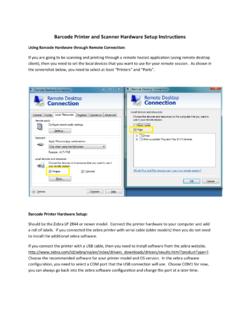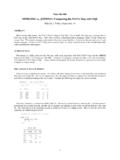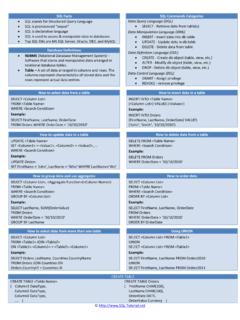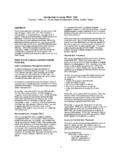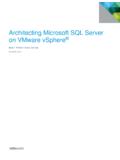Transcription of Excel SQL Queries - Fleet Maintenance Software
1 INTRODUCTION: You can extract data ( the total cost report) directly from the Truck Tracker SQL. Server database by using a 3rd party data tools such as Excel or Crystal Reports. Basically any Software that allows an ODBC, OLE or SQLNCLI connection will work as long as you have the proper connection string to the database. SQL SERVER ACCESS / LOGIN ACCOUNT INFO: Truck Tracker Software is coded to take advantage of the robust functionality of SQL. Server databases. To minimize the overall administrative effort required by the end user, Truck Tracker EX version creates its own SQL Server Express instance and attempts to keep it locked down.
2 Because of this control, there is no way to gain administrative access to the database without purchasing the un-locked Truck Tracker ST version. The ST version is meant for end users that require more control over the SQL Server Software . There are many extra things that the full version of SQL Server can do if you need to take advantage of them, such as custom reporting tools and advanced integration services. If you have the ST Server version of the Software , you need to have administrative access to install the database. So in this case, your username and password to the SQL. Server will be whatever you (or the SQL admin) decide.
3 If you have the EX Server version of the Software , you do not have administrative access to the database, but you do have read-only access to the Truck Tracker database. The EX version installs a single SQL authenticated login account that anyone can use for read-only access to the database. This login account is what you can use to extract the data you need. By default the username is TruckTrackerRead , and the password is TruckTr@ck3rR3@d (no quotes). You can change this default password to something more private in Truck Tracker Software . Go to the File menu and choose Database Tools . On this tools screen you can save a new password for the read-only connection.
4 Excel EXAMPLE: In this example, our goal will be to use Excel (2003 or 2007) to extract the Total Cost Report from the Truck Tracker SQL database. In order to connect to the SQL Server database, the computer that you are running Excel from needs to have the SQL Server client libraries installed. They might already be installed from some other Software such as SQL Server or SQL Server Management Studio. In the following examples, if you do not see the SQL Server options you will need to install the SQL Client Tools on your machine. In Excel 2003, select the Data menu, Import External Data, Import Data.
5 Select an existing data source if you have completed this step before, otherwise select the +New SQL Server Connection . In Excel 2007, select the Data ribbon tab, Get External Data group, From Other Sources button, From SQL Server . Enter the SQL Server name (this will be the same as the Server Name on the Truck Tracker login screen), and enter the login credentials (discussed above) . Once the connection is successfully made, choose the TruckTracker database, and then choose TotalCostReport_LifeTime . You can optionally save this connection information (and the password) in a file so that you do not need to do the connection next time.
6 Then click Finish. Choose where in Excel you want the data to be populated and press the OK button . Once the data is populated into Excel , you can use it to further sort, group and filter it. If you save this Excel file, it will remember the query, and you can continue to open the same file and refresh the data for the most recent result set. You can export the data from Excel by choosing File menu, Save As then save the Excel data as a CSV file. USING MICROSOFT QUERY: You will notice another option within Excel to get the data from the SQL database called Microsoft Query (or Database Query in Excel 2003).
7 This option is similar to the import option, but gives you greater control over the query being executed. In MS Query, you can store databases and Queries . Once you create these once you can select them again in the future without re-creating the data source or the query. At this point in time, there is a limited amount of publicly available knowledge about the Truck Tracker database tables and the relationships between them to be able to construct advanced Queries . You can certainly try to do your best given the descriptive table names and columns, but if you need additional information about the database to perform a query, you must contact your support provider.
8 I will be showing you a simple example of how to extract columns from a single table. If you have not created one yet you can choose <New Data Source> . Give the data source a name, choose the SQL Native Client or SQL Server driver and press Connect. Enter the server name and login credentials and press Options button. Change the Database to TruckTracker . Now you can optionally select a default table for your data source, although you are not required to. Now back to the Choose Data Source window. Choose the data source and press OK. Now you should see the Query Wizard Choose Columns screen. From here you can find the tables and columns you want in your query.
9 Next is the Filter Data screen where you can choose conditions to limit the amount of data returned. Then the Sort Order screen . When you are done with the Query you can save it, edit it further, or return the results to Excel . If you choose to Edit the query you will see the Microsoft Query And finally return the results to Excel .

